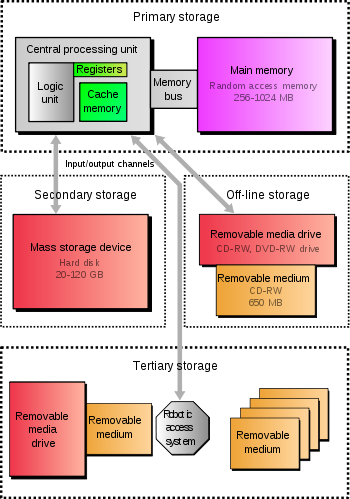Data organization and representation

A modern digital computer represents data using the binary numeral system. Text, numbers, pictures, audio, and nearly any other form of information can be converted into a string of bits, or binary digits, each of which has a value of 1 or 0. The most common unit of storage is the byte, equal to 8 bits. A piece of information can be handled by any computer or device whose storage space is large enough to accommodate the binary representation of the piece of information, or simply data. For example, the complete works of Shakespeare, about 1250 pages in print, can be stored in about five megabytes (40 million bits) with one byte per character.
Data are encoded by assigning a bit pattern to each character, digit, or multimedia object. Many standards exist for encoding (e.g., character encodings like ASCII, image encodings like JPEG, video encodings like MPEG-4).
By adding bits to each encoded unit, redundancy allows the computer to both detect errors in coded data and correct them based on mathematical algorithms. Errors generally occur in low probabilities due to random bit value flipping, or "physical bit fatigue", loss of the physical bit in storage of its ability to maintain a distinguishable value (0 or 1), or due to errors in inter or intra-computer communication. A random bit flip (e.g., due to random radiation) is typically corrected upon detection. A bit, or a group of malfunctioning physical bits (not always the specific defective bit is known; group definition depends on specific storage device) is typically automatically fenced-out, taken out of use by the device, and replaced with another functioning equivalent group in the device, where the corrected bit values are restored (if possible). The cyclic redundancy check (CRC) method is typically used in communications and storage for error detection. A detected error is then retried.
Data compression methods allow in many cases (such as a database) to represent a string of bits by a shorter bit string ("compress") and reconstruct the original string ("decompress") when needed. This utilizes substantially less storage (tens of percents) for many types of data at the cost of more computation (compress and decompress when needed). Analysis of trade-off between storage cost saving and costs of related computations and possible delays in data availability is done before deciding whether to keep certain data compressed or not.
For security reasons certain types of data (e.g., credit-card information) may be kept encrypted in storage to prevent the possibility of unauthorized information reconstruction from chunks of storage snapshots.
Comments
Post a Comment